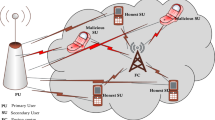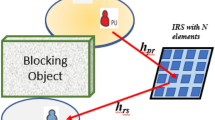Abstract
Wireless Communication technology has completely adopted the dynamic spectrum access policy due to the prevailing issues of spectrum scarcity. Cognitive Radio Networks have been the most successful strategy to overcome this issue of spectrum scarcity. Cognitive Radio Networks is the technology of dynamic spectrum access that is allowing clients of multiple types for transmitting data on a single channel. The unlicensed users also termed Secondary Users (SU) are allowed to function in the particular channel when the licensed user or the Primary Users (PU) is not present. When a PU arrives on that channel, the SU needs to vacate the particular frequency and continue the communication on another channel that is free. Such a phenomenon is known to be spectrum handoff. A spectrum handoff results in poor performance of the SU. In order to improve the performance of a SU, an effective algorithm governing the spectrum handoff is required. The two most effective algorithms governing the spectrum handoff are the Probabilistic Approach Algorithm (PAA) and the Channel Status Flag Bit Algorithm (CSFBA). This paper presents a comparative analysis of these two major algorithms on the basis of performance and other parameters like latency due to handoff, energy consumption accuracy as well as needs of memory. The results suggest which algorithm suits best for a given scenario.




Similar content being viewed by others
References
Aggarwal, M., Velmurugans, T., Karuppiah, M., Hassan, M. M., Almogren, A., & Ismail, W. N. (2019). Probability-based centralized device for spectrum handoff in cognitive radio networks. IEEE Access, 7, 26731–26739.
Bhattarai, S., Park, J.-M., & Lehr, W. (2020). Dynamic exclusion zones for protecting primary users in database-driven spectrum sharing. IEEE/ACM Transactions on Networking, 28(4), 1506–1519.
M. Amjad, M. H. Rehmani and S. Mao 2018 "Wireless multimedia cognitive radio networks: a comprehensive survey," in ieee communications surveys & tutorials, 20 2 1056–1103.
Mitola, J., & Maguire, G. Q. (1999). \Cognitive radio: making software radios more personal. IEEE Personal Communications, 6(4), 13–18.
Akyildiz, I. F., Lee, W. Y., Vuran, M. C., & Mohanty, S. (2006). \Next generation/dynamic spectrum access/cognitive radio wireless networks: a survey. Computer Networks Journal (Elsevier), 50, 2127–2159.
Haykin, S. (2005). Cognitive radio: Brain-empowered wireless communications. IEEE Journal on Selected Areas in Communications, 23(2), 201–220.
R. W. Thomas, L. A. DaSilva, and A. B. MacKenzie, “Cognitive networks,” in. Proc. of IEEE DySPAN 2005, 352–360, November 2005 Mahdi Zareei, A. K. M. Muzahidul Islam, Sabariah Baharun, Cesar Vargas-Rosales, Leyre Azpilicueta, Nafees Mansoor, “Medium Access Control Protocols for Cognitive Radio Ad Hoc Networks: A Survey”, Sensors (Basel), 17(9): 2136, Sep 2017.
Li, Q., Hu, R. Q., Qian, Y., & Wu, G. (2012). Cooperative communications for wireless networks: Techniques and applications in LTE-advanced systems. IEEE Wireless Communications, 19(2), 22–29.
Tuberquia-David, M., Hernández, C., & Martínez, F. (2019). Spectrum handoff reduction in cognitive radio networks using evolutionary algorithms. Journal of Intelligent & Fuzzy Systems, 36(6), 6049–6058.
S. Hoque, R. K. Karsh, S. Baishya and W. Arif, "Spectrum handoff performance in opportunistic and negotiated situations for cognitive radio networks," TENCON 2017 - 2017 IEEE Region 10 Conference, Penang, 2017, 1834–1838.
Y.Zhang, "Spectrum Handoff in Cognitive Radio Networks: Opportunistic and Negotiated Situations," 2009 IEEE International Conference on Communications, Dresden, Germany, 2009, 1–6,
Song, Y., Xie, J., & Wang, X. (2014). A novel united analytical model for broadcast protocols in multi-hop cognitive radio ad hoc networks. IEEE Transactions on Mobile Computing, 13(8), 1653–1667.
Weiss, T. A., & Jondral, F. K. (2004). \Spectrum pooling: an innovative strategy for the enhancement of spectrum eficiency. IEEE Communications Magazine, 42(3), 8–14.
Christian, I., Moh, S., Chung, I., & Lee, J. (2012). Spectrum mobility in cognitive radio networks. Communications Magazine, IEEE, 50(6), 114–121.
Liu, X., & Ding, Z. (2007). ESCAPE: a channel evacuation protocol for spectrum-agile networks 2nd ieee international symposium on new frontiers in dynamic spectrum access networks. Dublin, Ireland, 2007, 292–302.
E. Ahmed, L. J. Yao, M. Shiraz, A. Gani and S. Ali, "Fuzzy-based spectrum handoff and Channel selection for Cognitive Radio Networks," 2013 International Conference on Computer, Control, Informatics and Its Applications (IC3INA), Jakarta, Indonesia, 2013, pp. 23–28.
Cao, K., & Qian, P. (2020). Spectrum handoff based on dqn predictive decision for hybrid cognitive radio networks. Sensors (Basel)., 20(4), 1146.
El, A., Gouda, S. I., Rabia, A. Y., & Zakariya, M. A. (2018). Omar, Reactive spectrum handoff combined with random target channel selection in cognitive radio networks with prioritized secondary users. Alexandria Engineering Journal, 57(4), 3219–3225.
Tao Peng, Wei Wang, Qianxi Lu and Wenbo Wang, "Asymptotic performance of uplink resource allocation for OFDMA-based cognitive radio networks," 2008 11th IEEE Singapore International Conference on Communication Systems, Guangzhou, China, 2008, pp. 1509–1513
Xian Y., Xu C., Qian H. A Grade-Based Spectrum Handover Mechanism in Cognitive Radio System. In: Qian Z., Cao L., Su W., Wang T., Yang H. (eds) Recent Advances in Computer Science and Information Engineering. Lecture Notes in Electrical Engineering, vol 127. Springer, Berlin, Heidelberg, 2012.
Srinivasa, S., & Jafar, S. A. (2007). The throughput potential of cognitive radio: a theoretical perspective. IEEE Communications Magazine, 45, 73–79.
Q. Shi, D. Taubenheim, S. Kyperountas, P. Gorday, and N. Correal, “Link Maintenance Protocol for Cognitive Radio System with OFDM PHY,” IEEE DySPAN, pp. 440–443, April 2007.
Shah, M. A., Zhang, S., Kamran, M., et al. (2016). A survey on MAC protocols for complex self-organizing cognitive radio networks. Complex Adapt Syst Model, 4, 18.
C.-W. Wang and L.-C. Wang, “Modeling and Analysis for Proactivedecision Spectrum Handoff in Cognitive Radio Networks,” IEEE International Conference on Communications (ICC), 2009.
Bany Salameh H., Krunz M. (2011) Channel Assignment and Access Protocols for Spectrum-Agile Networks with Single-Transceiver Radios. In: Domingo-Pascual J., Manzoni P., Palazzo S., Pont A., Scoglio C. (eds) NETWORKING 2011. NETWORKING 2011. Lecture Notes in Computer Science, vol 6641. Springer, Berlin, Heidelberg
C. Han, J.Wang, and S. Li, \A Spectrum Exchange Mechanism in Cognitive Radio Contexts," IEEE International Symposiumon Personal, Indoor and Mobile Radio Communications, pp.1–5, September 2006.
Xu, Y., Li, G., Liu, Q., & Wang, Z. (2019). Resource allocation for OFDMA-based cognitive networks: an interference-efficient perspective IEEE 90th vehicular technology conference (VTC2019-Fall). Honolulu, HI, USA, 2019, 1–5.
Lee, W., & Akyildiz, I. F. (2012). Spectrum-aware mobility management in cognitive radio cellular networks. IEEE Transactions on Mobile Computing, 11(4), 529–542.
Nejatian, S., Syed-Yusof, S. K., Latiff, N. M. A., et al. (2013). Proactive integrated handoff management in cognitive radio mobile ad hoc networks. J Wireless Com Network, 2013, 224.
Abdel-Hamid, A. T., Zahran, A. H., & ElBatt, T. (2013). Improved spectrum mobility using virtual reservation in collaborative cognitive radio networks IEEE symposium on computers and communications (ISCC). Split, Croatia, 2013, 000476–000482.
Md. Nazmus Sakib Miazi Madiha Tabassum, Md. Abdur Razzaque, M. Abdullah-Al-Wadud 2015 An energy-efficient common control channel selection mechanism for Cognitive Radio Ad Hoc Networks”, annals of telecommunications 70 11–28.
Joseph Mitola, 2009 “Cognitive radio architecture evolution: annals of telecommunications”, annals of telecommunications, 64, 7–8, 419–441.
Aggarwal, M., Velmurugan, T., & Nandakumar, S. (2020). Dual processor based centralized device for spectrum handoff in cognitive radio networks. J. Electr. Eng. Technol., 15, 833–842.
Author information
Authors and Affiliations
Corresponding author
Additional information
Publisher's Note
Springer Nature remains neutral with regard to jurisdictional claims in published maps and institutional affiliations.
Rights and permissions
About this article
Cite this article
Aggarwal, M., Velmurugan, T. & Nandakumar, S. Comparative Analysis of Algorithms Governing Spectrum Handoff in Cognitive Radio Networks. Wireless Pers Commun 121, 1423–1435 (2021). https://doi.org/10.1007/s11277-021-08677-9
Accepted:
Published:
Issue Date:
DOI: https://doi.org/10.1007/s11277-021-08677-9




